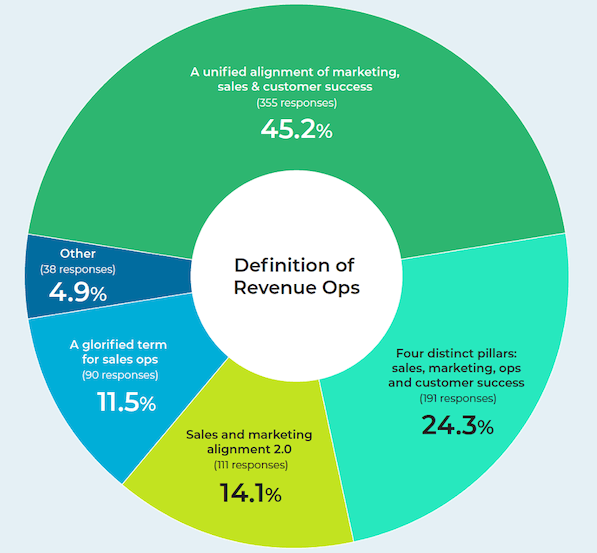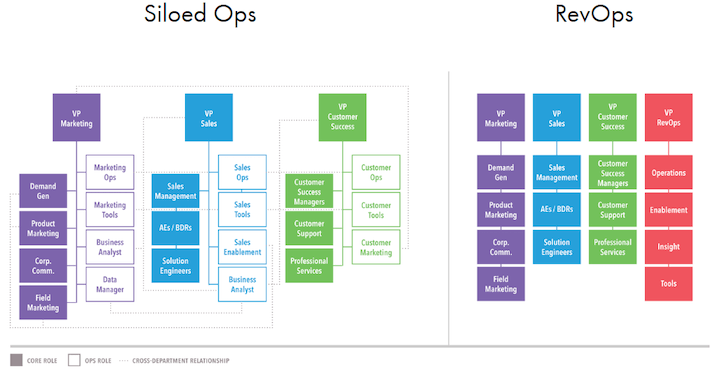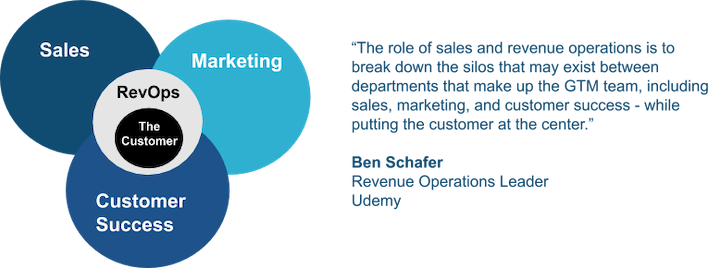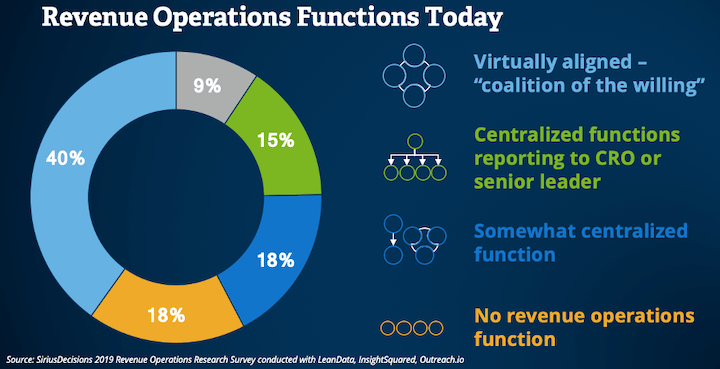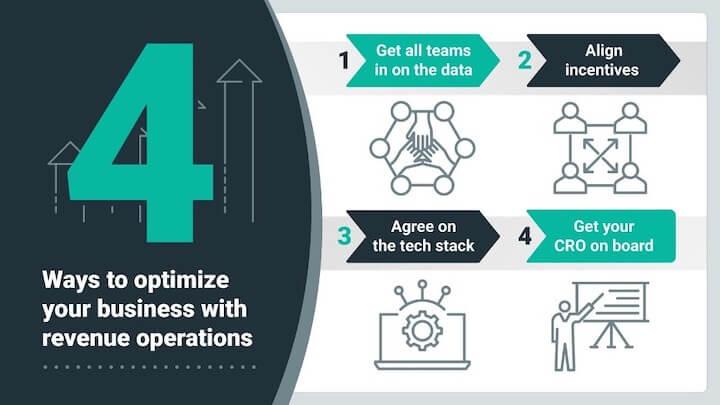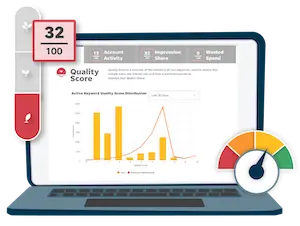
Revenue operations (RevOps) has become a common term in business lingo in recent times. As the name suggests, it refers to the management of the revenue funnel of any given business. But how exactly does that work?
Read on to understand:
- What RevOps is and how it differs from SalesOps
- The purpose and benefits of a RevOps department
- How to know if you need revenue operations
- How to implement RevOps
The need for revenue operations
According to a 2020 survey by McKinsey, 31% of businesses have fully automated at least one function within their organization. With companies rapidly moving towards automation for productivity, the current need is effective management of all departments to boost revenue.
This is the genesis of revenue operations—a function that has become a control room in the revenue funnel of a business. RevOps encapsulates multiple departments, functionalities, and assets. Previously stand-alone assets and tools are now managed by RevOps.
Different versions of the RevOps definition
According to a survey by Sales Hacker different people have different definitions of for RevOps:
- A unified alignment of marketing, sales & customer success
- Four distinct pillars: sales, marketing, ops, and customer success
- Sales and marketing alignment 2.0
- A glorified term for sales ops
For all intents and purposes, we’re going with Forbes’ definition: RevOps is the means of maximizing revenue potential for a business by aligning sales, marketing, and customer success teams into a unified revenue-generation engine.
All too often, the different teams within a company often get so caught up in their silo-specific growth and processes that they can’t see the woods for the trees.
For example, the sales team has their own sales targets, customer data, and reports to the sales manager. Similarly, the marketing teams have their own marketing campaigns and performance metrics and report to the marketing manager. This makes any coordination between teams both difficult and time-consuming. So, while they’re all working towards a common goal, they’re moving in different directions.
Revenue operations ensures both accountability and uniformity in operations between sales, marketing, and customer service. This leads to better management of resources, enhanced customer experience, and increased revenue for the business, creating a holistically beneficial relationship.
What does revenue operations have to do with marketing?
In short, marketing is one of three departments that the RevOps team is designed to support:
Sales
The RevOps team is on top of everything that goes on in the sales funnel. This helps them troubleshoot and fix any issues that may come up, allowing sales team members to focus on doing their job. From tracking quality leads with paid and organic traffic to engaging with prospects and finally closing a deal, sales teams can perform better with RevOps overhead management.
Marketing
Marketing teams usually work with more data and tech than other GTM (go-to-market) teams. RevOps helps streamline this tech, helping the marketing department to access data from other teams. This provides better collaboration and enhances your lead-generating content marketing strategy.
Customer success
As RevOps helps previously isolated teams work together, these teams can become more focused on customer needs. This leads to better communication and service, enhancing the overall customer experience. Effective RevOps adoption helps you build client relationships that last.
What’s the difference between revenue operations and sales operations?
The main difference between RevOps and Sales Ops is that while sales operations support the sales team with sales opportunities and all other aspects of sales exclusively, RevOps is responsible for operations across all marketing, sales, and customer success teams.
It works like this: If the object of sales is enabling the sales team to spend more time selling by reducing friction points, RevOps focuses on revenue generation in its entirety.
Benefits of revenue operations
There are several benefits to adopting revenue operations in a business. Some of the key advantages are:
1. Predictable business growth
Companies are now increasingly turning their focus on revenue growth predictions. These predictions are key in planning a streamlined strategy for revenue generation. From optimizing enterprise search marketing to investing in new markets, you can plan each strategy and test if it’s working. RevOps provides accurate metrics to predict your revenue trajectory.
2. Greater transparency between teams
An all-too-common scene in most cross-team meetings is the marketing team talking about SEO, the sales team talking about closing rates, and the paid media team talking about conversion rates. Whilst all three teams are essentially serving a common purpose, the lack of alignment means they are seldom aware of what the other is doing. This causes friction and an onslaught of blame games in case a glitch does indeed occur.
This is where RevOps comes in. It ensures that each team has full visibility over what the other teams are doing by creating alignment in all the handoff points. This in turn ensures that everyone across all teams is held accountable. For example, data on the impact of SaaS marketing on business should be accessible to all GTM teams. Better accountability naturally leads to greater transparency.
3. Enhanced collaboration among teams
RevOps facilitates collaboration among cross-functional teams. When teams work collaboratively towards a unified goal, they waste less time on infighting, and more time on achieving those goals. Historically, teams succeed more than individuals whilst working towards a streamlined end result. This reduces friction and improves the overall process.
4. Higher customer retention
RevOps streamlines processes for all GTM teams, thus allowing them to be more attentive to customer needs. This naturally boosts customer experience and leads to higher customer retention.
How do you know if you need revenue ops?
“We don’t know how to manage so many tools!”
“Our processes are a mess!”
“There’s no coordination between our teams!”
If you find yourself nodding in agreement to any of these statements, you need to bring RevOps into your business.
Traditionally, every team in an organization has its own tech and tool suite used for specific functionalities. However, the silo structure of teams can lead to an overlap of tools. This drives up your expenditure and makes a mess of your tech inventory.
RevOps addresses this issue by integrating the purchase, implementation, and management of tech at one unified point.
Businesses today have to constantly evolve to keep up with changing trends and technologies. So business processes also need to be regularly updated. RevOps involves all teams in the creation of new processes so everyone is on the same page to drive more conversions.
Disjointed teams are a major hindrance to a smooth revenue generation process. RevOps counters department conflicts and silos by changing the mindset from a myopic “own team” to a holistic view of revenue flow across the business. It essentially creates one super team from small self-contained units.
How do I start implementing revenue operations?
According to Gartner, 75% of high-growth companies will adopt RevOps by 2025. RevOps can be implemented to streamline your retail sales channel. You can start implementing RevOps in four main phases, namely:
- Audit
- Align
- Build
- Optimize
Audit
In this step, you audit your customer’s unique journey and try to identify the main pain points between the different departments. You do this by conducting thorough audits of:
- Your existing content. You then try to align it with your customer lifecycle and fill in the gaps.
- The existing tech in your marketing, sales, and customer success teams, to ensure they’re correctly tracking consumer movement and traffic.
- Your website to ensure there are conversion best practices in place.
Align
- Use Google Analytics to ensure you have a clear picture of your revenue funnel and review the overall business health.
- Audit all software to check for tech overlaps.
- Provide streamlined RevOps processes to your team for all inbound and outbound sales, content marketing and customer service.
Build
- Build a map for GTM teams for customer acquisition and onboarding.
- Build task queues for inbound and outbound sales including follow-up emails.
- Build a dedicated RevOps dashboard to show all blocks and pain points.
Optimize
- Set up a regular RevOps meeting schedule with the different heads of sales marketing and customer service so that everybody is aligned with the unified revenue generation process.
- Identify which function faces the biggest bottleneck each month and use preset playbook guides to address these bottlenecks.
- Set up a 12-month execution plan for the continued adoption of the RevOps strategy.
Improve the customer experience with RevOps
RevOps as a process is here to stay. It eliminates procedural gridlocks across departments, creates greater transparency across teams, and facilitates your lead generation process.
As companies move towards more streamlined growth plans, RevOps offers the perfect solution for the optimization and management of resources. With RevOps defining each hand-off point between departments across the entire revenue funnel, it’s easy to measure and track KPIs, thus further boosting productivity.

